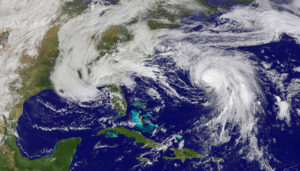New Program Investigates Bermuda’s Disaster Risk

Last year, the Risk Prediction Initiative (RPI) of BIOS expanded to include a locally-focused program called BermudaRisk. BermudaRisk investigates, through academic research, the risks to Bermuda’s society from natural hazards. This effort leverages RPI’s decades of experience in managing scientific research with relevance to risk management, and by collaborating with a network of local and international contacts in the fields of environmental science, catastrophe modeling, policy development, re/insurance, and disaster risk reduction.
While the main attention of RPI remains on global catastrophic risk, this subsidiary program brings a new element of focus to the local implications of climate change, natural hazard variability, and changes in vulnerability.
The goal of BermudaRisk is to provide scientific insights to inform decision-making for insurers, the public sector, as well as for marine, aviation and energy sectors. This was made possible through local sponsorship and support for a research grant by RPI member companies.
One question under investigation during the program’s first year is the local risk from tsunamis. Bermuda experienced a small but damaging tsunami wave in 1929, and researchers know that even modest waves can cause injury, loss of life, and problems for critical infrastructure. BermudaRisk has helped to lead the conversation about tsunamis by participating in educational meetings with the Emergency Measures Organization following this year’s annual regional tsunami exercise, called CARIBE WAVE 2016. Ongoing engagement on this topic with partner organizations will lead to better understanding about this rare but dangerous phenomenon.
Researchers are also exploring if Bermuda has entered a new phase of hurricane risk. Between 1963 and 2003, no major hurricanes deemed a threat by forecasters came within range of Bermuda. This was puzzling, as it came on the heels of a relatively active hurricane period through the 1950s. Is Bermuda now in a more risky era of hurricane activity? To illuminate this question, RPI and BermudaRisk have supported a project by a researcher from the University of Southern Mississippi to examine 1,000-year scale reconstructions of hurricane activity, by looking at periodic sediment deposits from storm surge in the island’s Spittal Pond and Mangrove Lake. As storm surge washes large-grain sand and marine deposits into these otherwise quiescent, algae-rich environments, these layers are preserved for geologists to examine later through the sediment record. These layers are “signatures” of hurricanes overwash deposits that are easily identified in core samples taken from these coastal bodies of fresh and brackish water.
In addition to developing research and providing scientific advice, BermudaRisk contributes to public awareness and education activities such as Hurricane Preparedness Week. Leveraging BIOS’s physical oceanography and atmospheric science expertise, locally-based monitoring programs, and a wide network of expert contacts, BermudaRisk is at the forefront of progress towards answers to these important questions about the island’s vulnerability.3333
